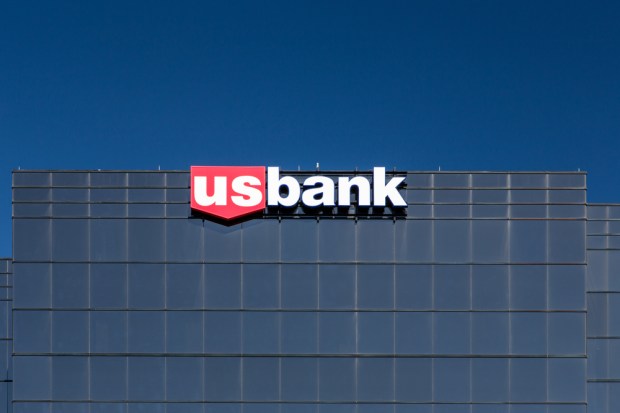US Bank Launches Loan To Compete With Payday Lenders

U.S. Bank is entering the small-dollar lending arena. Going forward, U.S. Bank depositors will be able to tap into an online, digital lending product aimed at offering a small cash infusion to solve near-term problems.
Called Simple Loan, the new product puts the nation’s largest regional bank in direct competition with payday, title and other short-term lenders.
“As a company, we are all focused on powering the potential of our customers. So, every day we work to be there in the moments that matter to them the most,” said Lynn Heitman, executive vice president, U.S. Bank consumer banking sales and support. “Sometimes those moments are the unexpected ones when customers need short-term access to funds they don’t have on hand. We saw this as a need we could help with by providing customers with a trustworthy, transparent loan option.”
The seventh largest U.S. bank by assets, Minneapolis-based U.S. Bancorp represents the first American big bank to bring short-term, small-dollar, no-credit-check loans to market. The announcement comes almost a full year after the announcement from the Office of the Comptroller of Currency (OCC) that it was rescinding Obama-era regulatory guidance that made it more difficult for banks to offer short-term loan adjacent product called a deposit advance.
Six months after that announcement, the OCC issued a new guidance actively encouraging banks to offer responsible short-term, small-dollar loans to their customers. The guidance did not change any regulations, but clarified the regulator’s stance on the loans.
“I applaud Comptroller [Joseph] Otting’s move to encourage national banks and federal savings associations to offer short-term, small-dollar installment loans,” said CFPB Acting Director Mick Mulvaney at the time. “Millions of Americans desperately need access to short-term, small-dollar credit. We cannot simply wish away that need. In any market, robust competition is a win for consumers.”
In fact, this area represents one of the few places where the CFPB’s interim director and the consumer advocacy group see eye to eye. Everyone seems to broadly agree that banks entering the space would create healthy competition that would boost consumer choice and create better options.
Options that are much-needed, according to Federal Reserve data. As of May 2018, about 40 percent of U.S. adults said they would not be able to cover a $400 unexpected expense with money they had on hand, and would have to cover it by selling something or borrowing money. Among those not able to pay the expense in full using cash or savings, 29 percent would have no other means to cover it.
But while there was loud agreement that it would be good if banks would step into the small-dollar lending arena, there was little evidence than any banks had a strong interest in doing so. Smaller short-term lending mostly tends to be high-risk and low-reward when it comes to taking in revenue.
U.S. Bank’s just-released option of Simple Loans indicates that there is at least some bank interest.
How It Works
Simple Loan, as its name implies, is designed to be pretty straightforward. Consumers can borrow any dollar amount from $100 to $1,000; loans then have to be paid back in three payments over three months. The bank charges a $12 fee for every $100 borrowed, and deducts payments from the consumer’s checking account via autopay. The charge goes up to $15 for every $100 borrowed if a customer repays the loan manually.
So a consumer who borrows $300 will pay $336 over the course of three months.
Payday loans, by comparison, charge $15 in fees per $100 on average, though the repayment period is much shorter: two weeks as opposed to three months.
U.S. Bank first tested this loan program in late 2016 and early 2017. During that time, it polled the program’s users and found the most common reason for use was running into a surprise expense or sudden cash flow issue.
“It’s a real short-term need,” said Heitman. “They were looking to bridge themselves through an unexpected scenario, or they’ve got inflows and outflows that are just mismatched.”
The program, according to U.S. Bank, is made possible by the power of automation. The $12 fee on a $100 loan (paid back over three months) is not profitable if it takes up any amount of loan officer time. But in the mobile age, digital processes and automation of underwriting have made it possible for U.S. Bank to offer loans to consumers in need, while at the same time making money on the product itself.
“Financial institutions are in a place where so much of what was manual is now automated, and customers are more comfortable with automated solutions,” Heitman said. “It’s an alignment of the stars that the time is right now for us to get out there.”
The loans will require customers to have a credit history, and it will report the data about the loans to credit agencies so that consumers can use them to build up their credit.
Reactions So Far
The program has only been out in the wild for a day, and so reactions are limited. Still, the early reviews from consumer groups seem to be positive.
“This is the first time a bank has made small installment loans available to customers with poor credit scores on a widespread basis. It’s a game changer, because the loans have affordable payments limited to 5 percent of each paycheck and prices seven to eight times lower than payday loans,” Nick Bourke, head of Pew Charitable Trusts’ consumer finance project, told PYMNTS.
There remains room for improvement, he noted, as the fee structure could be more incremental than it is presently.
“But overall, this is a positive development, because so many Americans who have been excluded from the financial mainstream will now get access to affordable credit.”
A positive development, as Bourke stated, but one that needs compounding. One bank opening up this service will not be enough. U.S. Bank does not plan to advertise Simple Loan broadly, partly because it will only be available to existing depositors and partly to hold down associated expenses.
“This is a solution where it’s going to be episodic for the customer,” U.S. Bank’s Heitman said. “We want to make sure they are aware that the product exists for them to access if they have a situation.”
And, of course, it has to work – if expenses actually overrun revenue, we imagine U.S. Bank will pull back out of short-term lending.
But if a viable, profitable, bank-backed model is found at U.S. Bank? Short-term lending could be a soon-to-change landscape, with perhaps more mainstream banks hazarding the field.
